Japanese iced coffee is like a cool summer hug in a cup! It’s made by brewing hot coffee straight over ice, which locks in all the delicious flavors. This technique keeps the coffee vibrant and invigorating. You get a rich taste that’s super smooth. It’s easy to whip up—just grab some ice and your favorite beans! Curious about brewing methods, equipment, and best practices? Stick around, and we’ll spill all the secrets to make your iced coffee game strong!
At a Glance
- Japanese iced coffee, or aisu kohi, is brewed by pouring hot coffee directly over ice, preserving flavors and enhancing taste.
- Originating from Dutch traders in Japan, it became popular in the 1920s, adapting cold brewing methods from tea.
- Recommended brewing tools include Chemex or Hario V60, a scale, and a kettle for precise temperature control.
- Coffee selection varies, with light to medium roasts preferred for their bright acidity and unique flavors, such as Colombian or African beans.
- Serve immediately in a clear glass with fresh ice, and pair with light desserts to complement the coffee’s refreshing nature.
The Origin of Japanese Iced Coffee
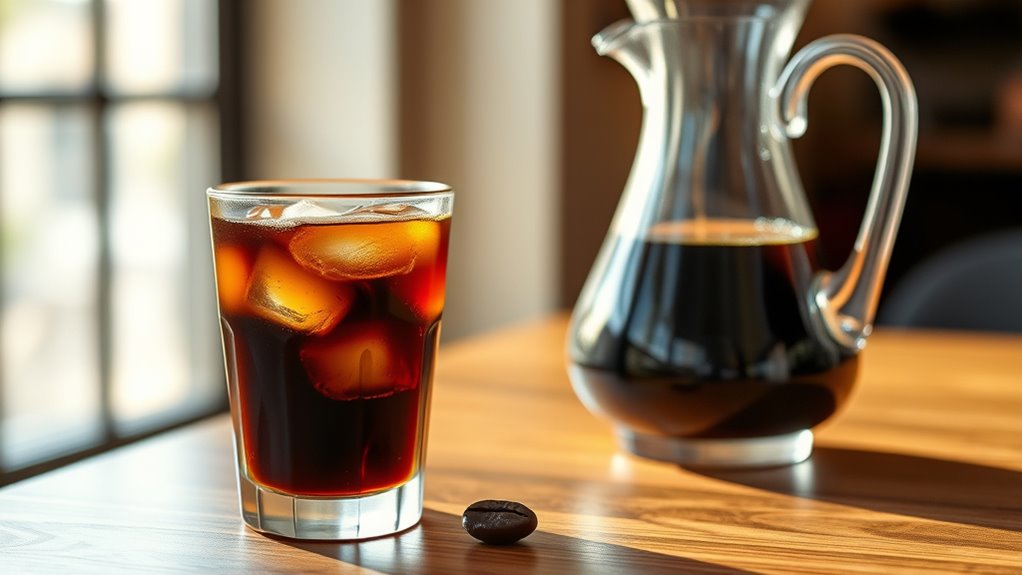
When you think about iced coffee, it’s easy to picture a revitalizing drink on a hot summer day, but did you know Japan has a pretty cool backstory for its iced coffee?
It all started way back when Dutch traders brought coffee to Japan, adapting their cold brewing methods from tea. They found cold brewing super handy for long voyages.
Fast forward to the 1920s, and Japanese coffee traditions took off, creating a whole vibe around iced coffee, or aisu kohi.
The unique method of brewing hot coffee directly onto ice not only preserved flavors but also brought an invigorating twist to those sweltering summers! This process is crucial for savoring the rich flavors of the coffee, enhancing its taste and aroma.
Brewing Equipment for Japanese Iced Coffee
If you’ve ever sipped on an invigorating cup of Japanese iced coffee, you know it’s all about the right gear!
You’ll want a Chemex or Hario V60 as your brewing tools, both known for their clean extraction. Don’t forget a scale to nail that perfect coffee-to-water ratio, and a kettle for hitting the ideal coffee temperature.
Ice? You’ll need plenty—about half the brewing volume! A good grinder and some stirring utensils will make your coffee sing. Additionally, using reusable filters can enhance the flavor while minimizing waste, making your iced coffee experience even better.
With the right setup, you’ll feel like a barista in your own kitchen, ready to impress friends with your iced coffee skills!
The Brewing Method Explained
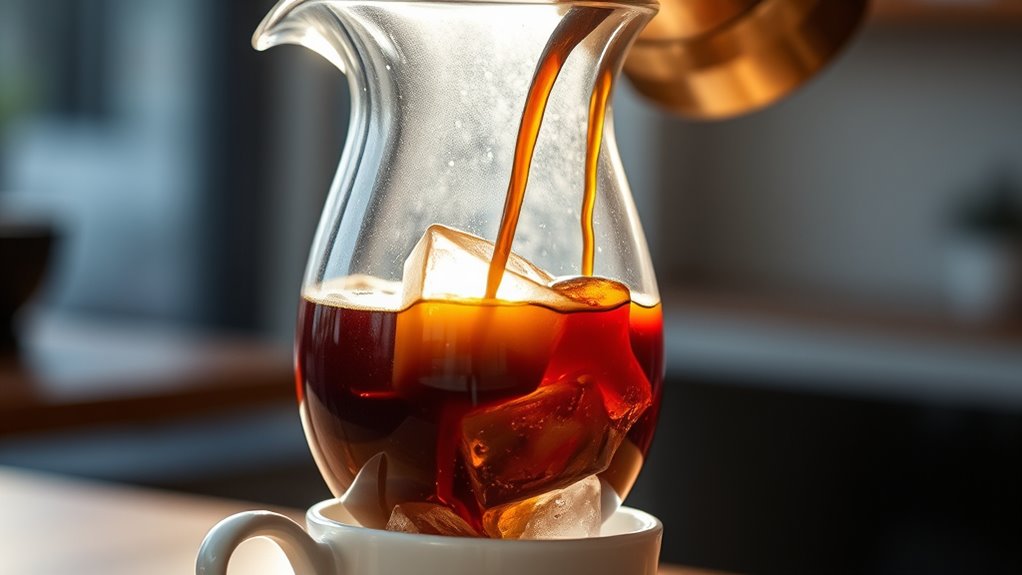
Ready to plunge into the delightful world of Japanese iced coffee? You’ll love these brewing techniques!
Start by adding ice to your vessel, then set up your coffee grounds in a dripper. Bloom those grounds with a splash of hot water—trust me, it’s worth the wait!
Add ice to your vessel, set up your dripper, and bloom those coffee grounds for a delightful start!
Gradually pour the rest of the hot water, keeping it slow and steady for perfect flavor nuances. Aim for a brew time of 2 to 4 minutes, and remember, the grind size matters!
Once brewed, swirl it all together, and you’re ready to sip on something truly invigorating. Enjoy every drop!
For an equally rich experience, consider using a French press for a different brewing method that enhances the coffee’s body and flavor.
Coffee Selection and Flavor Profiles
Choosing the right coffee beans is like picking out the perfect outfit for a big night out—it totally sets the vibe! Your coffee selection can really amp up those flavor profiles. Here’s a quick guide to help you choose:
| Bean Origin | Flavor Notes | Roast Level |
|---|---|---|
| African Beans | Bright acidity, fruity notes | Light to Medium |
| Central American | Medium body, balanced acidity | Light to Medium |
| Japanese Beans | Unique aromas, distinct flavors | Light to Medium |
| Peru Cajamarca | Subtle nuances, soft water | Light to Medium |
| Dark Roasts | Bitter, smoky (less preferred) | Dark |
Pick wisely, and you’ll brew magic! When selecting coffee for a percolator, consider the ultimate ground coffee that enhances extraction and flavor.
Understanding Brewing Ratios
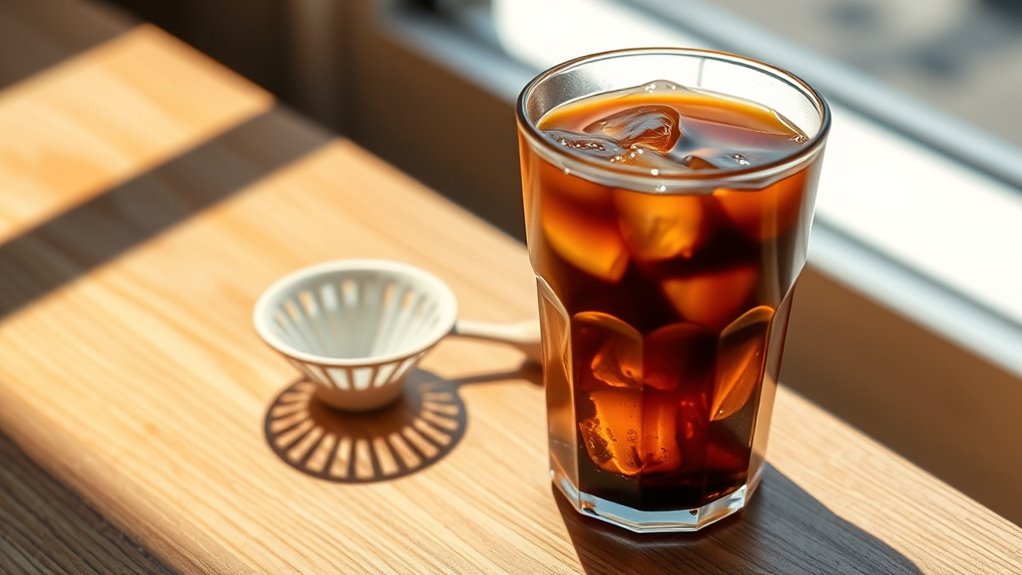
When you’re diving into the world of Japanese iced coffee, understanding brewing ratios can feel like decoding a secret recipe. You’ll typically work with a water-to-coffee ratio of 1:14 to 1:16.
But here’s the twist: you split that water between hot brewing and ice! A common method is a 60/40 split, which helps maintain flavor balance while maximizing brewing efficiency.
So, if you want that perfect cup, weigh your coffee and water precisely. Trust me, nailing those ratios is key to avoiding weak or overly strong brews. With the right cold brew coffee machine, you can experiment with these ratios effortlessly.
And who doesn’t want to impress friends with a killer iced coffee?
The Science of Extraction and Cooling
If you’ve ever wondered why your homemade iced coffee doesn’t taste quite as amazing as that café version, let’s explore the fascinating world of extraction and cooling! Here’s the scoop:
- Hot water speeds up extraction dynamics, pulling out all those yummy flavors.
- Rapid cooling techniques lock in bright, vibrant tastes and aromas.
- The temperature shock halts extra chemical reactions that can ruin your brew.
- Ice dilution balances flavors, keeping your coffee strong and rejuvenating.
- Using brewing methods such as a Keurig can enhance the extraction process for a perfect iced coffee.
Comparing Japanese Iced Coffee With Other Cold Coffee Methods
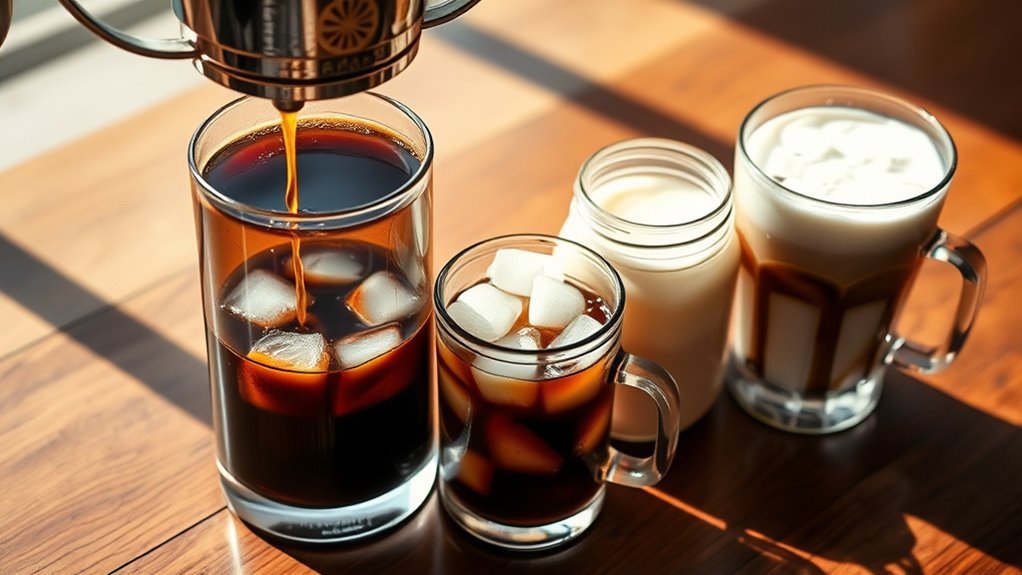
Now that we’ve tackled the science behind extraction and cooling, let’s chat about how Japanese Iced Coffee stacks up against other cold coffee methods.
JIC stands out with its flavor complexity and bright acidity, thanks to that hot water hitting ice. Cold brew? It’s smoother but lacks the zing.
Regular iced coffee can lose some of its magic while cooling—bummer, right? Cold drip takes forever and needs fancy gear.
With JIC, you’re looking at about three minutes for a vibrant, aromatic cup. So, if you want quick and delicious, JIC is your new best friend—no special skills required! Additionally, the grind size importance is crucial in achieving the best flavor extraction, much like in traditional brewing methods.
Best Practices for Brewing Japanese Iced Coffee
Brewing Japanese Iced Coffee can feel like a fun little science experiment, and trust me, it’s way easier than it sounds!
Brewing Japanese Iced Coffee is a delightful mix of science and simplicity—get ready for a refreshing adventure!
Here are some best practices to nail those brewing techniques and enhance your flavor:
- Use a scale to measure coffee and water precisely.
- Add ice to your brewer before you start brewing; it cools everything down fast!
- Bloom your coffee for 30 to 45 seconds with double the water weight.
- Stir gently after brewing to mix those delicious flavors evenly.
Colombian coffee beans are known for their rich flavors and are a great choice for this brewing method.
With practice, you’ll find your perfect balance, and soon you’ll be sipping like a pro!
Enjoy the journey!
Cultural Impact and Popularity in the U.S
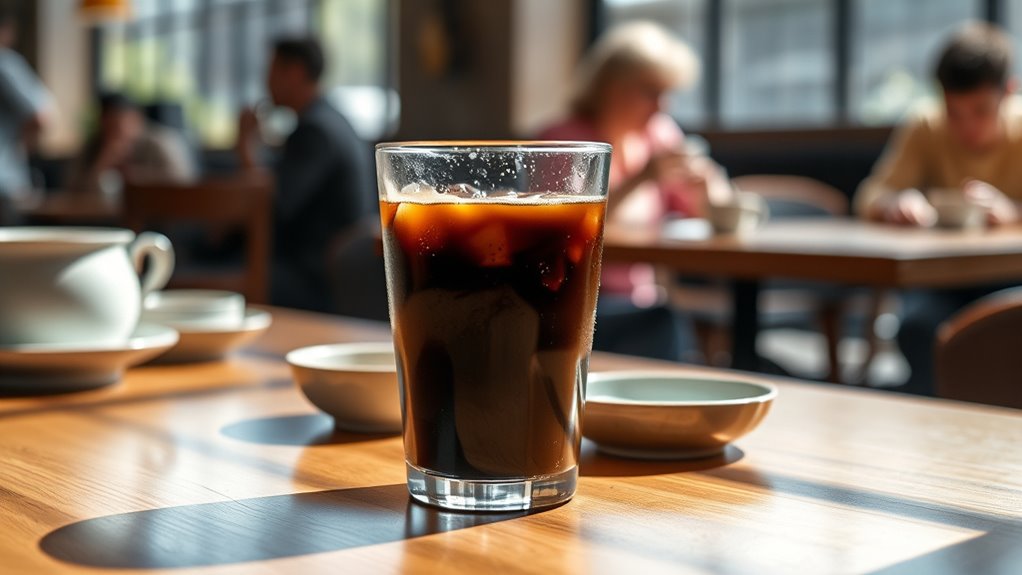
Japanese iced coffee isn’t just a tasty drink; it’s become a star in the U.S. coffee scene! This delightful brew sparked a cultural exchange, blending Japanese tradition with our love for specialty coffee.
You’ve probably noticed how millennials and Gen Z are all about unique flavors and quick prep times. As iced coffee’s popularity soars, this method’s bright, clean taste stands out among the sugary options. Many coffee enthusiasts also seek non-dairy creamers to enhance their iced coffee experience, catering to diverse dietary preferences.
It’s inspiring cafes and home brewers to get creative, driving exciting consumer trends. So next time you sip on this invigorating drink, remember—you’re part of a cool coffee revolution! Cheers to that!
Serving Suggestions and Enjoyment Tips
When you’re ready to enjoy your iced coffee, the way you serve it can totally elevate the experience!
Here are some fun tips to make your coffee moment special:
Here are some delightful tips to enhance your iced coffee experience and make every sip special!
- Serve it immediately at the ideal serving temperature, right after brewing.
- Use fresh ice cubes in a clear glass to showcase its beautiful color.
- Pair it with light desserts or fruity snacks to enhance those bright flavors.
- Stick to minimal sweeteners—let that delicious coffee shine!
Additionally, consider using high-quality beans that have undergone the quest for the perfect coffee bean to truly elevate your iced coffee experience.
With these tips, you’ll create a delightful coffee experience that everyone will want to join in on. Enjoy every sip!





